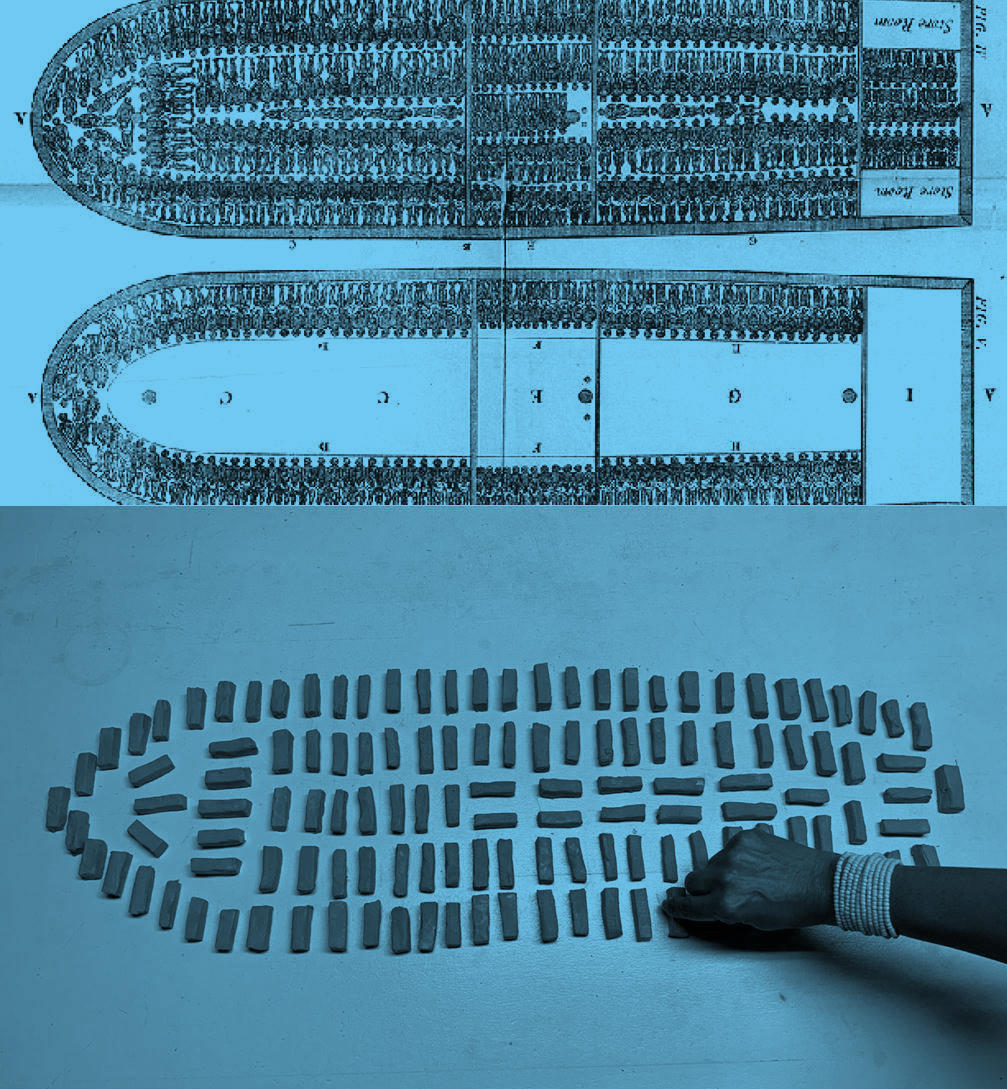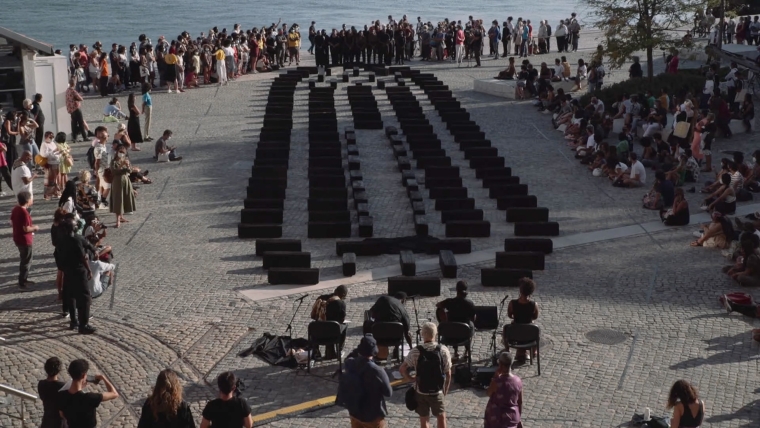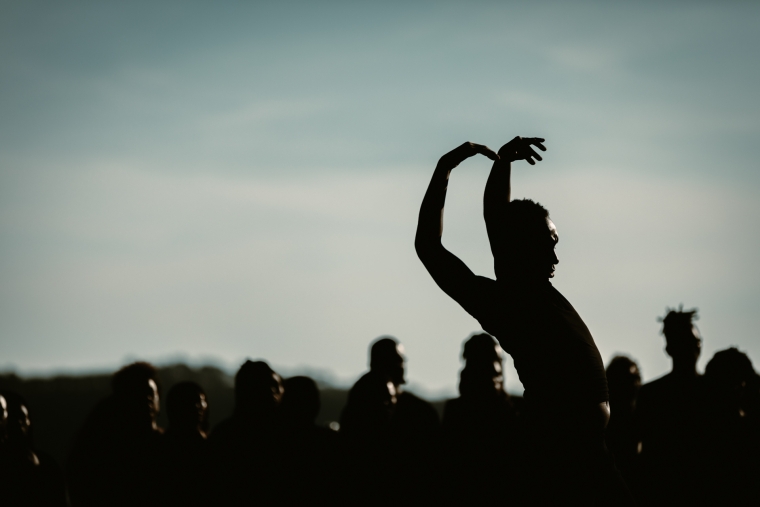
Grada Kilomba, studio test for “The Boat”, 2021. Courtesy of the artist.
The Boat
A continent with millions of people cannot be discovered nor one of the longest and most horrendous chapters of humanity – Slavery – can be erased.
Grada Kilomba
Synopsis
I
The Boat extends itself along a platform like a garden, in the public space, preferably close to a waterfront or a port, forming a simple composition of benches, which mimic a “ship with enslaved people”.
In the Western imaginary, a boat is easily associated with glory, exploration and the maritime expansion, illusorily described as “discoveries”. A continent, however, with millions of people cannot be discovered, as it already exists.
This old and primary fantasy that a continent and its people only come to existence through the presence of the coloniser was central to the European politics of enslavement, during several centuries.
This narrative of erasure is part of Western cities and inscribed in their innumerable monuments, which not only romanticise the colonial historical past, but also erase one of the longest and most horrific chapters of humanity – Slavery.
The Boat, in opposition, reveals not the “glorious” boat of the past centuries, but rather its content – reversing the storytelling.
The blocks of wood draw a silhouette that exposes history and the inside of these boats, the bodies. It reveals not the decks, but the erased and “forgotten” holds of the boats and the frugal spaces created to accommodate the bodies of millions of enslaved Africans by the European empires.
What stories are told? How are they told? And told by whom? These are questions that can be raised by the public, once entering The Boat.
The distance between the blocks creates “entrances” and endless paths, which like a labyrinth, invite the public to enter, to walk and to be inside of The Boat.
The Boat becomes than as a garden of remembrance, recognition, memory, contemplation, and ceremony.
II
The rectangular and uniformal shape of the blocks reveals them as metaphorical tombs. As a physical allusion, which give “habitat” to a history of dehumanisation, and give a place of recognition and a place of rest to thousands of enslaved people, and its descendants in the different African diasporas.
Some of these metaphorical tombs have a poem inscribed on their surfaces. The poem interacts directly with the public, who reads them and by doing so, bow to them.
This choreography of contemplation is typical of a memorial, as a space for rituals and ceremonies to a history that must be remembered and that cannot be forgotten.
III
When history is not told properly its barbarity is repeated. It comes a violent ghost, that keeps interrupting our present. The Boat can be seen as a public burial, a dignifying burial that tells history properly. A space where memory can be produced.
IV
The Boat is unveiled to the public with a happening, where movement and a song of lamentation are performed.
Several people from the African diasporas, from different generations, are invited to become part of the ensemble, with whom them performance is staged.
This community becomes the voice, the body and the storyteller of a history that has been made memorised.
The Boat becomes the ceremony and the physical presence of what has to be remembered.
|
Grada Kilomba is a Portuguese artist based in Berlin, whose work draws on memory, trauma, violence, and the post-colonial condition. Best known for her subversive writing and poetic imagery, Kilomba published Plantation Memories: Episodes of Everyday Racism in 2008. Reprinted in multiple editions and translated to different languages, the book examines, via a psychoanalytic lens, the methods used to dehumanise and oppress Black people throughout history. In her multimedia installations, Kilomba creates a critical and immersive space of storytelling, to explore what she calls the “colonial wound”, using performance, choreography, staged reading, theatre, video, photography and installation. Her work has been presented in major international venues such as Lubumbashi Biennale (2019), Berlin Biennale (2018); Documenta (Kassel, 2017), São Paulo Biennale (2016), among many other. Heroines, Birds and Monsters is her first solo exhibition in the United States, at the Amant Foundation, Brooklyn.
|
O Barco / The Boat is Grada Kilomba’s first large-scale installation. Stretching 32 meters along the Tagus river, it invites the audience to enter a garden of memory in which a poem, translated into various languages – from Yoruba and Kimbundu to Creole and Setswana, as well as Portuguese, English and Arabic – rests on burnt wooden blocks, recalling forgotten stories and identities. In the Western imaginary, a ship is easily associated with glory, freedom, and maritime expansion, described as “discoveries” but Kilomba’s boat carefully draws the space created to accommodate the bodies of millions of Africans, enslaved by European empires. A performance in three acts, in which several generations of Afro-descendant communities are the central interpreters, turns the O Barco / The Boat into a place of acknowledgement, a garden of memory, but also a viewpoint to the future.
This project is commissioned and co-produced by BoCA, maat and Kunsthalle Baden-Baden, in partnership with Câmara Municipal de Lisboa/EGEAC within the programme Lisboa na Rua'21. The production is support by ArtWorks.
|






